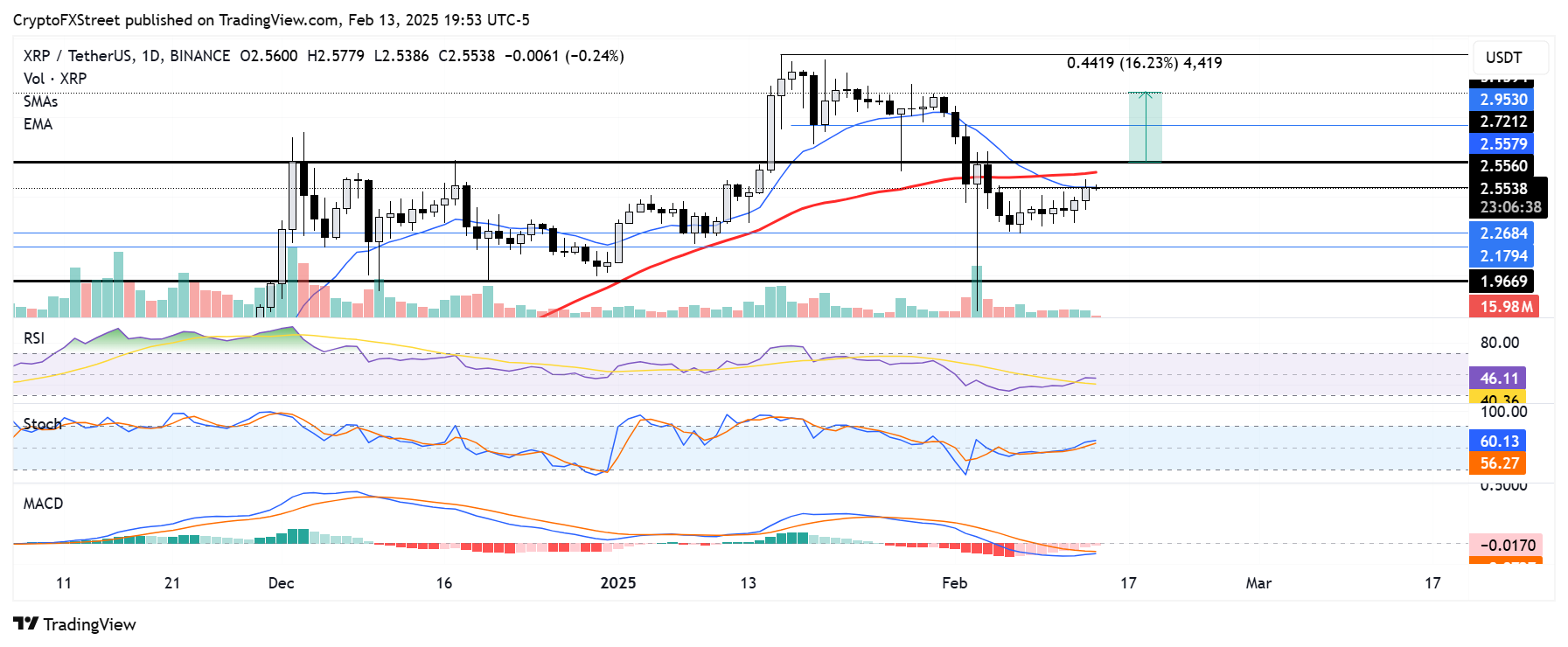Ripple's XRP on verge of potential breakout as SEC acknowledges Grayscale XRP ETF filing
- The SEC acknowledged Grayscale's filing to convert its XRP Trust to an ETF.
- XRP ETFs could be approved considering the new SEC administration's regulatory reforms.
- XRP could rally to $3.15 if it validates a rounded bottom pattern and its technical indicators flip to bullish momentum.
Ripple's XRP is up 4% in the early hours of Friday following the Securities and Exchange Commission (SEC) acknowledgment of Grayscale's 19b-4 filing to convert its XRP Trust to an ETF.
SEC acknowledges Grayscale's XRP ETF filing
The SEC acknowledged the New York Stock Exchange (NYSE) 19b-4 filing for Grayscale to convert its XRP Trust into an ETF.
While acknowledging ETF filings don't guarantee their approval, it shows that the SEC is open to the possibility of considering the option.
Next, the SEC is expected to acknowledge XRP ETF filings from other issuers, including Bitwise, Canary Capital, WisdomTree and 21Shares. Once the products get to the SEC's federal register, a 240-day window opens for the agency to decide whether or not to approve the ETFs.
Bloomberg analyst Eric Balchunas and James Seyffart have predicted that XRP ETFs have a 65% chance of approval.
SO, for everyone asking what this means — the SEC has *acknowledged* @Grayscale/@NYSE’s 19b-4 application to convert its $XRP Trust into an ETF.
— Eleanor Terrett (@EleanorTerrett) February 13, 2025
No, it doesn’t mean automatic approval and it doesn’t even guarantee the SEC will approve it down the line.
So why is it notable?… https://t.co/GICXgobYsZ
The acknowledgment shows the difference between the current SEC administration and that of Gary Gensler, which refused to give room for other crypto ETFs apart from Bitcoin and Ethereum ETFs.
The Ripple vs SEC case remains critical amid the whole XRP ETF application process. For example, if the SEC approves an XRP ETF, it could signal the end of its case against Ripple.
Most crypto community members expect the SEC to abandon the appeal filed by the former administration against Judge Analisa Torres' ruling in its case with Ripple, considering the latest regulatory reforms in the agency.
The SEC and Binance jointly requested a 60-day pause in their legal proceedings, citing the impact of the newly established SEC Crypto Task Force on regulatory developments. A similar agreement could occur in the SEC's case against Ripple.
SEC Commissioner Hester Peirce, who heads the task force, previously stated that the unit will seek to clarify the status of certain cryptocurrencies under the new regulatory changes in the agency.
If XRP is classified among cryptocurrencies that are not considered securities, it could mark the end of its four-year case with the SEC. Such an outcome could boost adoption and attract inflows toward the remittance-based token.
XRP could rally to $3.15 if its technical indicators flip bullish
XRP saw $3.81 million in futures liquidations in the past 24 hours, per Coinglass data. The total amount of long and short liquidations accounted for $2.47 million and $1.35 million, respectively.
XRP is testing the $2.55 level, strengthened by the 14-day Exponential Moving Average (EMA) and 50-day Simple Moving Average (SMA).
If XRP overcomes this hurdle, reclaims the $2.72 level, and holds it as a support, it will validate a rounded bottom pattern that could send the remittance-based token toward the $3.15 level.

XRP/USDT daily chart
However, a strong rejection at $2.55 or $2.72 could see XRP finding support at $2.26.
The Relative Strength Index (RSI) line crossed above its moving average and is testing the neutral level line. A successful crossover will indicate a flip toward bullish momentum in the underlying market trend.
Meanwhile, the Moving Average Convergence Divergence (MACD) is testing its moving average red line while posting receding histogram bars. A successful crossover in this indicator will also signal a trend shift toward bullish momentum.
Ripple FAQs
Ripple is a payments company that specializes in cross-border remittance. The company does this by leveraging blockchain technology. RippleNet is a network used for payments transfer created by Ripple Labs Inc. and is open to financial institutions worldwide. The company also leverages the XRP token.
XRP is the native token of the decentralized blockchain XRPLedger. The token is used by Ripple Labs to facilitate transactions on the XRPLedger, helping financial institutions transfer value in a borderless manner. XRP therefore facilitates trustless and instant payments on the XRPLedger chain, helping financial firms save on the cost of transacting worldwide.
XRPLedger is based on a distributed ledger technology and the blockchain using XRP to power transactions. The ledger is different from other blockchains as it has a built-in inflammatory protocol that helps fight spam and distributed denial-of-service (DDOS) attacks. The XRPL is maintained by a peer-to-peer network known as the global XRP Ledger community.
XRP uses the interledger standard. This is a blockchain protocol that aids payments across different networks. For instance, XRP’s blockchain can connect the ledgers of two or more banks. This effectively removes intermediaries and the need for centralization in the system. XRP acts as the native token of the XRPLedger blockchain engineered by Jed McCaleb, Arthur Britto and David Schwartz.

